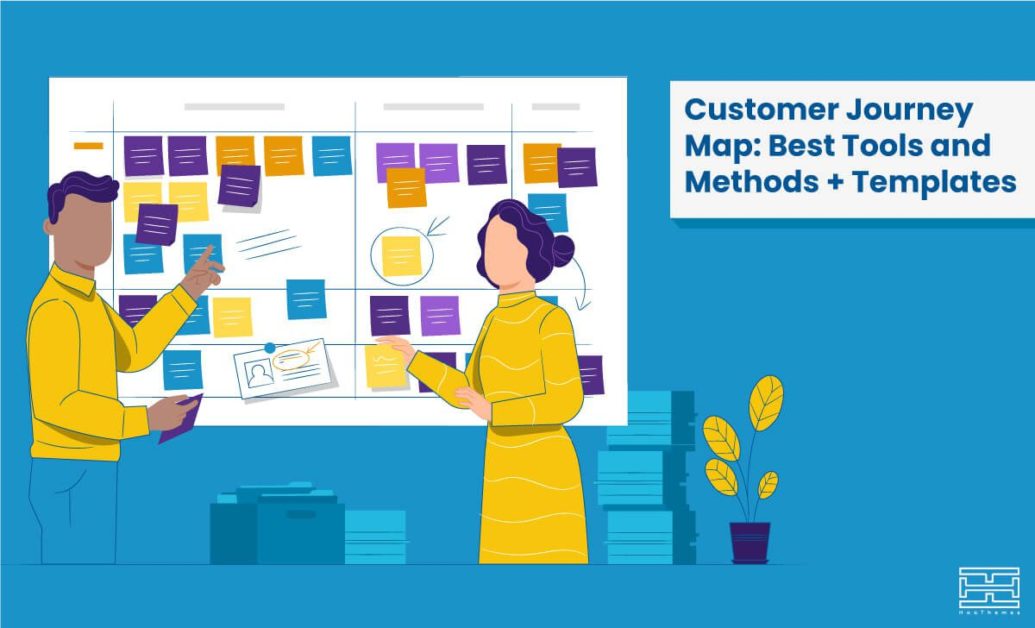As customers’ interactions have become more complex, creating a customer journey map is more crucial than ever. With a journey map, you will have a clear picture of your customers. It helps you understand the customer journey to the conversion goal and purchase your products or services.
Mapping the user journey requires deeply understanding your customers and their touchpoints. That’s the only way you can create a great customer experience.
This article will discuss everything you need to know about customer journey mapping to ensure that you meet customers’ expectations. So without further delay, let’s get started.
Relevant content: Shh! Don’t Share This Insider Secret About CRAP Design Principles
What Is a Customer Journey?
Before defining what a customer journey map is, let’s see what the customer journey is itself. Customer journey refers to a customer’s interactions with a company and its products or services. This journey usually starts when the customer becomes aware of a brand.
What Is a Customer Journey Map?
A customer journey map is a diagram that visualizes the steps of the customer journey. It depicts the process a customer goes through to complete the conversion goal. This goal can be conducting a purchase, submitting a form, creating an account, or anything else. A user journey map helps you understand customers’ experiences with your business and if they are achieving the goals or not.
It would be best to consider all the touchpoints, including social media, emails, your website, etc., to find out what customers need at each stage. This way, you can understand how to encourage your customers to take your desired actions.
The process of user journey mapping involves researching your target audience and collecting feedback to understand their needs. Without these insights, you won’t be able to improve your customer experience effectively.
Relevant reading: Google Analytics Heat Mapping: A Few Quick Tips to Get the Best Results
Why Is Creating a Customer Journey Map Essential?
Creating a customer journey map enables you to optimize your customer success strategy. It helps you improve the customer experience, which in turn increases your revenue.
Now, let’s take a look at the other benefits of user experience maps:
1- Increasing the Customer Retention Rate
A user journey map helps you discover the areas where you can improve the customer experience. This can prevent customers from leaving you for the competitors as it minimizes pain points. 32 percent of customers would abandon a brand they love after one bad experience.
With user journey mapping, you can identify customers who are likely to churn. By tracking and understanding the behavior of these customers, you can detect them before they leave.
2- Building a Customer-Centric Mindset
Journey mapping enables you to build a customer-centric mindset throughout your organization. It can help all the departments to define goals considering customers’ needs. Marketing, sales, and service teams will be able to develop customer-centric strategies.
3- Reducing Costs
A buyer journey map can help you reduce customer service costs and improve your service too. You can monitor customers’ suggestions, common objections, and pain points. Therefore, you will be able to reduce the number of customers who contact customer service.
Moreover, a better customer experience will increase your referrals. Word-of-mouth marketing will lower your customer acquisition costs as people trust referrals more than advertising.
4- Increasing Sales
User experience maps help you better address customers’ pain points so people will be more likely to convert. You can discover how to optimize touchpoints to offer the best customer experience.
A UX journey map gives you insights into how to improve your website for more sales. Can visitors quickly find what they are looking for? Can they navigate through your website smoothly? Is the call to action clear enough? By removing frictions on your website, you can be sure that your conversions will increase.
5- Increasing Customer Satisfaction
As user journey mapping enables you to deliver the best customer experience, satisfaction will increase. It will help you create emotional connections with your customers, and employees will provide excellent customer support.
6- Understanding Your Target Market
Another benefit of user journey mapping is that you will better understand your customers’ demographics and psychographics. This way, you will know your target audience, and you won’t waste your efforts on the wrong people.
By mapping the user journey, you’ll figure out the type of customer interested in your offer and their needs and pain points. So you can focus your marketing efforts on the right customers.
7- Improving Your Customer Service Strategy
With customer journey mapping, you will be able to implement proactive customer service. You can identify the moments of satisfaction and friction in the customer experience. Therefore, you can plan a more effective customer service strategy.
An example of proactive customer service is sending personalized emails to inform customers about shipping delays.
Relevant reading: The Simple Formula for Success in Checkout Page Design
What Should a Customer Journey Map Include?
No matter what your customer journey map looks like, these are the key elements you should include:
1- Buyer Persona
The persona is the customer experiencing the journey, and your journey map should be about them. Remember that you should only choose one persona for each map to create more compelling user journey maps.
2- Scenario and Expectations
Scenario refers to the experience you want to map out. It should be related to the persona’s goal and their expectations from experience. For example, the scenario can be returning a product, and the customer’s expectations might include a clear return policy.
The scenarios aren’t always real; they can also describe an anticipated journey (for products still in the design stage, for instance.)
Journey maps are usually used for scenarios that involve a process or a series of events.
3- Journey Stages
Your journey map should include all the stages in the customer journey. These stages are different for each scenario. They will help you organize the information you need to have on the map.
For example, for an eCommerce scenario, the stages can be:
- Discovering the brand
- Comparing options
- Purchasing a product
- Using the product
- Sharing the experience
4- Thoughts, Feelings, and Actions
For each journey stage, you should include the customer’s actions, thoughts, and feelings.
Actions are the customer’s behaviors and the steps they take to reach the goal. Remember, you don’t need to mention a detailed step-by-step list of all the interactions.
Besides actions, describe the customer’s thoughts and motivations using the collected information through customer research.
Then you should add a single line that indicates the customer’s emotional ups and downs throughout the experience. This will show you when the customer is satisfied and when they are frustrated.
5- Opportunities
This element of the customer journey map refers to the opportunities to improve the customer experience. These are the insights you gain from mapping the user experience.
How to Create a Customer Journey Map?
Now that you know what a customer journey map is, it’s time to find out how to create one. Here are the steps you need to take to make an experience map:
1- Set Clear Goals
First of all, you must know why you are creating a UX journey map. It would help if you asked yourself a series of questions like:
- What are the goals of this journey?
- To which target audience does it belong?
- What is the experience you are going to map?
Based on these questions, you need to create a buyer persona who represents your potential customer. A buyer persona helps you create a more compelling customer journey map.
2- Research Buyer Personas
Now, you have to research to develop your buyer personas. Here’s where collecting feedback from prospects and existing customers come in handy. Remember, you have to get feedback from people who somehow have interacted with your business and are interested in your offer.
Creating buyer personas will give helpful insights into customer behavior that enables you to make better journey maps.
3- Define the Buyer Personas’ Goals
After developing your buyer personas, you should figure out what goal they want to achieve by going through the journey. For example, a customer might want to know how your product can help them pay a reasonable price.
Discovering the paths visitors take on your website helps you identify these goals. A first-time visitor might only browse through your website, while an existing customer might log in to their account.
Try to compile a list of all users’ activities on your website. This list will help you identify all customer touchpoints and the goals that match each of them. Then, determine what goals belong to each stage of the user journey. This way, you can find out how to help your customers reach those goals more quickly.
4- Define All the Customer Touchpoints
Touchpoints are any interaction of customers with a business. It’s necessary to make a list of all of the touchpoints of your prospects and customers. You should also consider the ones you expect customers to use.
Keep in mind this is an essential step in customer journey mapping. That’s because it shows you the actions customers are performing and how you can ease the process for them.
To have a complete list of touchpoints, you must identify your traffic sources, such as social media, email marketing, referrals, etc. You can find out where your traffic comes from by checking your Google Analytics. At all of these touchpoints, you should provide information about how your prospects or customers can get in touch with you. This could be via an interactive voice response call center, live chat, email support, etc. The idea is to give them a mode through which they can remain in contact with your brand at each of those touchpoints.
5- Identify Pain Points
At this stage, you can identify the pain points in the buyer journey with the data you’ve collected. You can also list out the areas where things are working fine to improve them.
By interviewing customers and staff, you can identify pain points and obstacles more concretely. Try to find out if customers are achieving their goals or not. See where they get frustrated or confused and where the friction points are. And find where and why people abandon your business.
6- Remove the Roadblocks
Now that you know the pain points and roadblocks, you should try to fix them. Understand what needs to be changed and how. Is making a few small changes enough, or should you start all over again?
For example, your customers might be complaining about your lengthy and complicated checkout process. That means maybe you should optimize it and make it more user-friendly.
Remember, when optimizing each stage of the user journey, you must consider the conversion goal. So each change should contribute to that single goal.
7- Analyze the Customer Journey Map
Creating the user journey map is not the end. Next, you should test and analyze it to see how it’s working. Without customer journey analytics, you won’t know how effective your buyer journey map is, and your efforts might come to nothing.
This step is essential to understand if you are meeting customers’ needs. Analyzing the UX journey map helps you ensure that you are delivering the best customer experience possible.
8- Improve and Optimize
After you’ve analyzed your experience map, you should figure out how to change it to make it better. And you can be sure these changes are effective as they are related to customers’ pain points.
Bear in mind that the customer journey mapping process should be continuous as your customers are constantly changing.
Best Customer Journey Mapping Tools
Here are some of the best customer journey map tools that can help you create more meaningful user experience maps:
1- Watch Them Live
Understanding user behavior is key to customer journey mapping. Therefore, using a behavior analysis tool such as Watch Them Live would be a great idea. By installing this tool on your website, you can track visitors’ interactions using heatmaps and session replays. Let’s see how each feature helps you create an insightful buyer journey map.
Heatmaps
Heatmapping is a data visualization technique that uses colors to visualize data. By creating heatmaps for your web pages, you can discover the most and least popular areas on your website.
Analyzing heatmaps is an excellent way to identify distractions that prevent users from converting. For example, there might be an image on your landing page which visitors mistake for a clickable element, distracting them from the CTA.
Session Replays
Session replays are recorded videos from visitors’ journeys on your website. These videos enable you to see how visitors navigate through your website and what activities they perform. Watching session replays is one of the best ways to identify user pain points on your website. You can see if any elements are confusing or what makes them abandon your website.
Pricing
- Free trial
- Free plan
- Pro plan – $29 per month
- Advanced plan – $99 per month
- Enterprise plan – $399 per month
Since WTL is absolutely free to start, why not create an account and try it out?
2- UXPressia
UXPressia is a customer experience management tool that enables you to visualize customer experience. You can also make buyer journey maps with your team in real-time. Besides journey maps, with this tool, you can build buyer personas and impact maps.
Features
- Customer profiles
- Customer segmentation
- Customizable templates
- User journeys
Pricing
- Free trial
- Free plan
- Starter plan – $16 per user per month
- Pro plan – $36 per user per month
- Enterprise plan – custom pricing
3- Microsoft Visio
Microsoft Visio is a visualization tool that allows you to draw diagrams and flowcharts. You can use this software to simplify the process of user journey mapping. This tool also offers premade templates, graphs, and stencils which you can use.
Features
- Diagrams
- Flows
- Planning
Pricing
Microsoft Visio offers both subscription plans and a one-time purchase option.
Subscription Plans
- Free trial
- Plan 1 – $5 per user per month
- Plan 2 – $15 per user per month
One-Time Purchase
- Standard – $329.99
- Professional – $649.99
4- Custellence
Custellence is a customer journey map tool that helps you create journey maps and share them with your team. This tool is user-friendly, and you can quickly learn to use it. The flexibility of this tool allows you to create most kinds of customer journey maps.
Features
- Customizable templates
- Customer accounts
- Customer database
- Collaboration tools
Pricing
- Free plan
- Essential plan – €20 per month
- Team plan – €60 per month
- Team+ plan – €100 per month
- Enterprise plan – custom pricing
5- Smaply
Smaply is a customer experience management platform that lets you visualize journey maps. You can create and share customer journey maps, personas, and stakeholder maps. This tool helps you understand customer needs, pain points, and feelings more easily.
Features
- Customer accounts
- Customer activity tracking
- Customer database
- Customer history
Pricing
- Free trial
- Starter plan – €25 per month
- Regular plan – €50 per month
- Business plan – €100 per month
- Enterprise plan – custom price
Customer Journey Map Templates
Here are some free customer journey map templates which you can download:
1- Current State Template
This template helps you to map the current customer experience. For each stage of the journey, make sure to include the customer’s feelings, actions, touchpoints, channels, and the assigned ownership of each touchpoint.
Usually, the customer journey stages are awareness, consideration, decision, retention, and advocacy.
You can download the current state template here.
2- Future State Template
The future state journey map looks similar to the current state, but it focuses on how you like the customer journey to look like. The current state helps you identify the customer experience gaps and customer pain points, and roadblocks. Based on these insights, you need to create an ideal future state journey map. Click here to download this future state template.
3- Day in Life Template
With the day in the life journey map, you can picture the customer’s daily routine. The map should include all their daily interactions with other people, whether related to your business or not. A well-designed template should map out all these activities in chronological order.
You can use this customer journey map to gain insights into all the customer’s needs, problems, and thoughts. This user journey map also helps you determine the moments in their daily life when you can help them the best way possible. Here you can download the day in life template.
4- Service Blueprint Template
The service blueprint map is a diagram that visualizes the service processes. This type of journey map facilitates designing a new process or improving the existing ones. Though the service blueprints focus on a company’s service processes, they also include the customer’s perspective.
A service blueprint is more in-depth than a customer journey map. It considers the customer’s experience and all the employee interactions and support processes that might not be visible.
You can download this service blueprint template here.
The physical evidence in the template refers to tangible elements that influence the customer perception, such as your product, website, and emails.
Customer Journey Map Examples
Now, let’s take a look at some customer journey map examples.
1- Current State Map Example
Below you can see a real-life example of a current state user journey map from USA.gov. It includes the customer’s activities, feelings, and needs. This information has helped them identify opportunities to improve the experience.
2- Future State Map Example
Here’s a future state map from Carnegie Mellon University. The journey map is about the students’ first visit to the university. Creating this user journey map helped them design a new website to provide a better experience for the newcomers. The future state map shows the ideal journey they want the student to have.
You can see it includes the persona’s thoughts, feelings, actions, touchpoints, proposed changes, and scenarios. Proposed changes indicate how to optimize each stage of the journey.
3- Day in Life Map Example
The journey map below represents a day in the life of a frequent business traveler. It consists of the personas’ interactions with the business and other people and describes the persona’s actions, thoughts, and emotions at each stage.
4- Service Blueprint Map Example
Here’s an example of a service blueprint journey map. You can see it includes the main elements of this type of journey map: customer journey, frontstage employee actions, backstage actions, and the support processes.
Closing Thoughts on Creating a Customer Journey Map
Creating a customer journey map will help you better understand your customers’ experiences. Therefore, you will be able to meet customers’ expectations at every stage of the journey.
As customer experience matters more than ever, journey maps are essential to growing your business and increasing conversions.
And make sure to check out more of our blogs:
- How to Repost on Instagram: 5 Simple Ways
- Become an Expert in Influencer Marketing [A Definitive Guide]
- How to Boost Instagram Engagement [10 Proven Ways]
- How to Get More Followers on Instagram: 8 Pro Tips for Instagram Growth
- Best Open Source WordPress Themes and Frameworks
- How to Schedule Instagram Posts [+Top Instagram Schedulers]
- How to Generate More Real Estate Leads Like a Pro
- How to Create an Instagram Content Calendar
- Cloud Computing Explained: An Amateur’s Guide
- How to Get Verified on Instagram [+Instagram Verification Requirements]
- AiGrow Review: All You Must Know About This Instagram Growth Service
- How to Outsmart the YouTube Algorithm [2021 Update]
- Instagram Insights Explained [Views, Reach, Impressions]


![Read more about the article How to Improve eCommerce Conversion Rate in 2022 [5 Easy Ways]](https://www.hoothemes.com/wp-content/uploads/2022/02/how-to-improve-ecommerce-conversion-rate-300x157.jpg)

![Read more about the article How to Monetize a Website and Boost Your Income [14 Proven Methods]](https://www.hoothemes.com/wp-content/uploads/2022/07/How-to-Monetize-a-Website-and-Boost-Your-Income-300x157.png)




